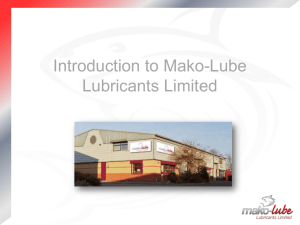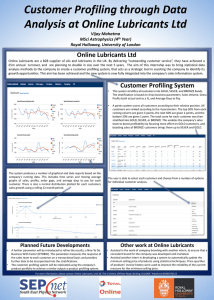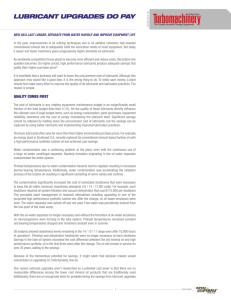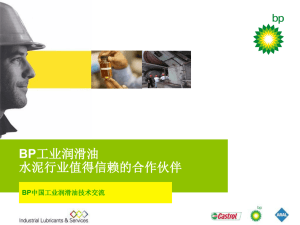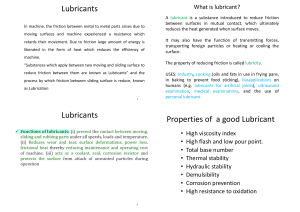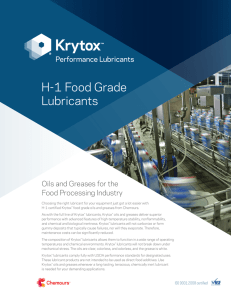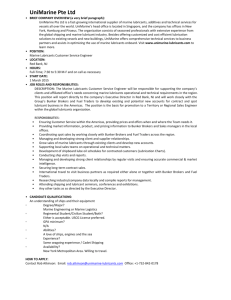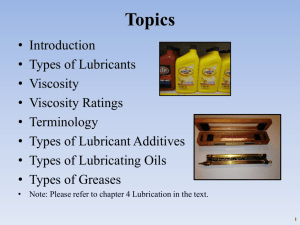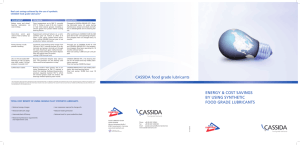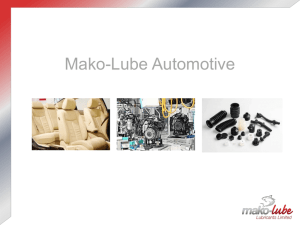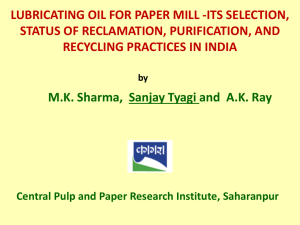Siberian Federal University
advertisement
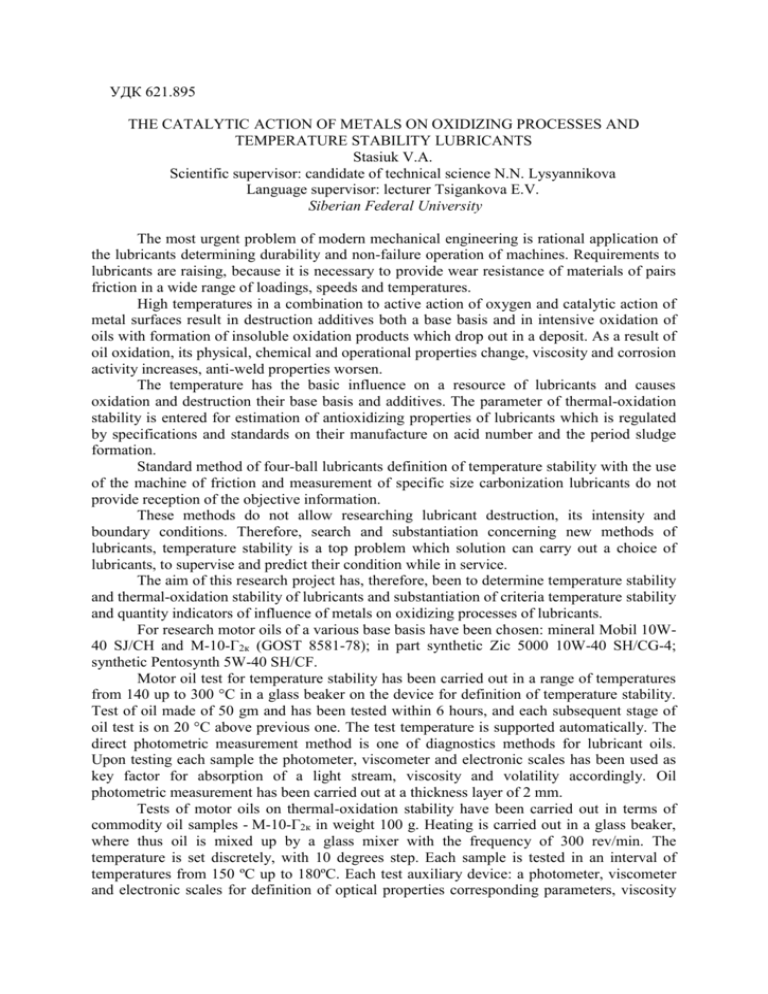
УДК 621.895 THE CATALYTIC ACTION OF METALS ON OXIDIZING PROCESSES AND TEMPERATURE STABILITY LUBRICANTS Stasiuk V.A. Scientific supervisor: candidate of technical science N.N. Lysyannikova Language supervisor: lecturer Tsigankova Е.V. Siberian Federal University The most urgent problem of modern mechanical engineering is rational application of the lubricants determining durability and non-failure operation of machines. Requirements to lubricants are raising, because it is necessary to provide wear resistance of materials of pairs friction in a wide range of loadings, speeds and temperatures. High temperatures in a combination to active action of oxygen and catalytic action of metal surfaces result in destruction additives both a base basis and in intensive oxidation of oils with formation of insoluble oxidation products which drop out in a deposit. As a result of oil oxidation, its physical, chemical and operational properties change, viscosity and corrosion activity increases, anti-weld properties worsen. The temperature has the basic influence on a resource of lubricants and causes oxidation and destruction their base basis and additives. The parameter of thermal-oxidation stability is entered for estimation of antioxidizing properties of lubricants which is regulated by specifications and standards on their manufacture on acid number and the period sludge formation. Standard method of four-ball lubricants definition of temperature stability with the use of the machine of friction and measurement of specific size carbonization lubricants do not provide reception of the objective information. These methods do not allow researching lubricant destruction, its intensity and boundary conditions. Therefore, search and substantiation concerning new methods of lubricants, temperature stability is a top problem which solution can carry out a choice of lubricants, to supervise and predict their condition while in service. The aim of this research project has, therefore, been to determine temperature stability and thermal-oxidation stability of lubricants and substantiation of criteria temperature stability and quantity indicators of influence of metals on oxidizing processes of lubricants. For research motor oils of a various base basis have been chosen: mineral Mobil 10W40 SJ/CH and М-10-Г2к (GOST 8581-78); in part synthetic Zic 5000 10W-40 SH/CG-4; synthetic Pentosynth 5W-40 SH/CF. Motor oil test for temperature stability has been carried out in a range of temperatures from 140 up to 300 °C in a glass beaker on the device for definition of temperature stability. Test of oil made of 50 gm and has been tested within 6 hours, and each subsequent stage of oil test is on 20 °C above previous one. The test temperature is supported automatically. The direct photometric measurement method is one of diagnostics methods for lubricant oils. Upon testing each sample the photometer, viscometer and electronic scales has been used as key factor for absorption of a light stream, viscosity and volatility accordingly. Oil photometric measurement has been carried out at a thickness layer of 2 mm. Tests of motor oils on thermal-oxidation stability have been carried out in terms of commodity oil samples - М-10-Г2к in weight 100 g. Heating is carried out in a glass beaker, where thus oil is mixed up by a glass mixer with the frequency of 300 rev/min. The temperature is set discretely, with 10 degrees step. Each sample is tested in an interval of temperatures from 150 ºС up to 180ºС. Each test auxiliary device: a photometer, viscometer and electronic scales for definition of optical properties corresponding parameters, viscosity and volatility have been used. Tests of lubricant oils have been carried out up to the value of absorption value of a light stream equal 0, 7-0, 8 units or until changes of relative viscosity changes no more than by 25 %. Pic.1 - Relative viscosity factor dependence on the test motor oil temperature After a few experiments the following conclusion has been made. Definition methods of temperature stability and thermal-oxidation lubricants stability can allow to establish new factor for an estimation of destruction processes and oxidations of commodity lubricants which expand the information on their quality. Also it can allow to choose on a design stage of machines and units, to improve classification and identification oils system using operational properties groups. As a result of research, regression dependences of volatility changing, factors of relative viscosity and of a light stream absorption on temperature and time of the test commodity oils can identify lubricants on operational properties groups on such parameters as: the temperature started destruction additives, speed of process destruction, limiting temperature destruction, the temperature started destruction a basis and complex criterion of temperature stability. The integrated criterion catalytic action of metals on oxidizing processes of a lubricant is offered. It is established, that at high temperatures there is a chemical adsorption of surfaceactive substances of the additives alloying base oil owing to what, processes of formation the blanket are proceed intensively. Thus, essential influence on processes of self-organizing tribology systems is rendered with superficial energy of a firm material, and also a lubricant being, at the present stage of science and technics one of constructive elements of units and machines. References 1. GOST 981-75. Motor oils. The method of definition stability against oxidation. 2. GOST 18136-72. Motor oils. The method of definition stability against oxidation in the universal device. 3. GOST 11063-77. Motor oils. The method of definition stability on the induction period sludge formation. 4. GOST 23175-78. Motor oils. The method an estimation of motor properties of definition thermooxidative stability.
